| |
|
| Date |
Event |
|
2018.03.08
|
Low-coordinate rare-earth single-ion magnets were successfully constructed via intercalation of lanthanide ions into bulky phenol matrix. Interestingly, the rare-earth complexes crystallized in the same way with the pro-ligand ArOH (Ar = 2,6-Dipp2C6H3, Dipp = 2,6-diisopropylphenyl), allowing for the natural magnetic dilution studies by doping complexes into pro-ligand matrix. Magnetic measurements and theoretical studies demonstrated that both the oblate type dysprosium and prolate type erbium analogs exhibited single-ion magnets (SIMs) behaviors. The bulky phenol ligands provided strong uniaxial ligand field, making the dysprosium SIM possessing blocking barrier up to 961 K.
|
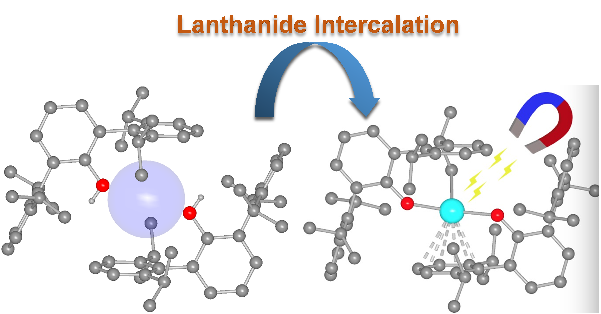
|
2018.01.10
|
We report the crystallographic determination of Gd2@C79N for the first time. This molecular magnet with a collective high-spin ground state (S = 15/2) generated by strong magnetic coupling (JGd-Rad = 350 ± 20 cm–1) has been unambiguously validated by magnetic susceptibility experiments. Gd2@C79N has quantum coherence and diverse Rabi cycles, allowing arbitrary superposition state manipulation between each adjacent level. The phase memory time reaches 5 μs at 5 K by dynamic decoupling. This molecule fulfills the requirements of Grover’s searching algorithm proposed by Leuenberger and Loss.
|
| |
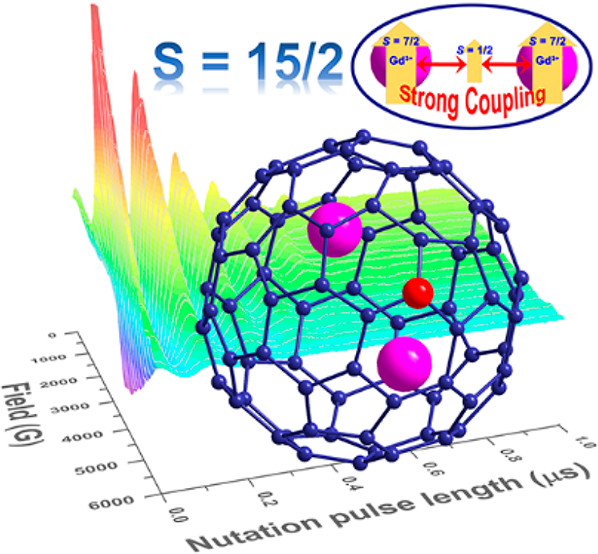 |
|
2017.11.20
|
The core–shell structure of endohedral fullerenes results in good protection of the encapsulated spin carriers from the environment. In this research, the quantum coherence behavior of the endohedral fullerene Sc3C2@C80 in CS2 solution is characterized from 5 K to room temperature. Below the critical temperature of around 140 K, the inner group is hindered, and the EPR spectrum consists of a single broad line. The spin carriers display a maximum phase memory time of 17.2(7) μs at 10 K. In the high temperature region, the inner group is mobile, and the EPR spectrum consists of 22 homogeneously broadened lines due to isotropic hyperfine coupling. The maximum phase memory time for each transition is around 139(1) ns at 200 K which allows arbitrary superposition state manipulations to be performed. This research demonstrates that Sc3C2@C80 displays temperature-crossover behaviour due to weak interaction between the Sc3C2 core and the C80 shell.
|
| |
 |
|
2017.03.06
|
High-field electron paramagnetic resonance and magnetometric measurements were applied to investigate the magnetic intramolecular Co–Co interactions in three dinuclear cobalt(II) complexes. Simulation results based on the multispin model reveal that the complexes are weakly ferromagnetically coupled and that the isotropic exchange coupling constants differ slightly for the three complexes. Moreover, the competing effects of zero-field splitting and magnetic coupling on the temperature-dependent magnetic susceptibility were analyzed.
|
| |
 |
|
2017.02.08
|
By substituting donors from S to Te, we synthetised a series of tetrahedral Co(II) complexes with chalcogen donors, which exhibited strong magnetic uniaxial anisotropies and slow relaxations as SIMs. We realized the fine-tuning of the ligand field while keeping the coordination geometry virtually unchanged, yielding the first tellurium-coordinated SIM.
|
| |
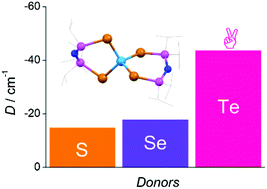 |
|
2017.04.13
|
Hybrid organic-inorganic perovskites (HOIPs) can have a diverse range of compositions. These materials have several common features, including their classical ABX3 perovskite architecture and the presence of organic amine cations that occupy the A-sites. Current research in HOIPs tends to focus on metal halide HOIPs, which show promise for use in solar cells and optoelectronic devices; however, the other subclasses also exhibit a diverse range of physical properties. In this Review, we summarize the chemical variability and structural diversity of all known HOIP subclasses. We also present a comprehensive account of their intriguing physical properties. Moreover, we discuss the current challenges and future opportunities in this exciting field.
|
| |
 |
|
2016.12.12
|
Two pseudotetrahedral cobalt(II) complexes exhibiting slow magnetic relaxation under an applied direct-current field are investigated recently. The weak easy-plane anisotropy is accurately determined by highfield/high-frequency electron paramagnetic resonance spectroscopy. In addition, hysteresis loops are observed for the two compounds at very low temperatures.
|
| |
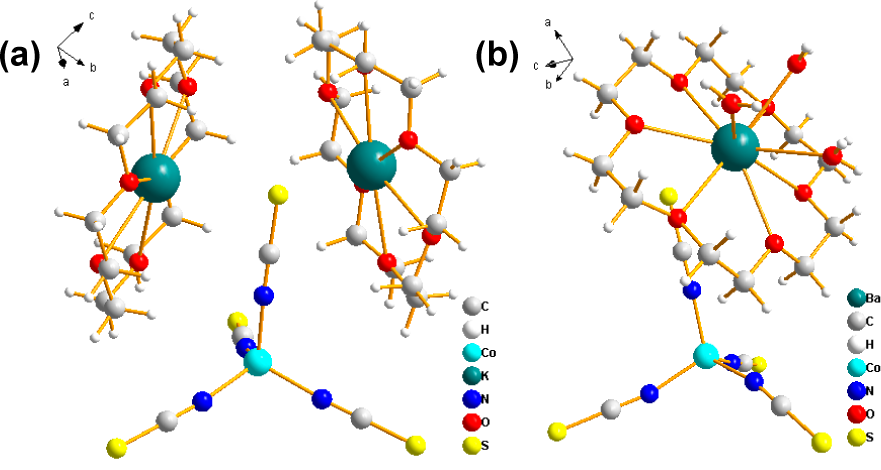 |
|
2016.12.12
|
We report that two-coordinate cobalt imido complexes featuring highly covalent Co=N cores exhibit slow relaxation of magnetization under zero direct-current field with a high effective relaxation barrier up to 413 cm−1, a new record for transition metal based SMMs. We use two theoretical models to investigate the anisotropy of these complexes: single-ion model and Co−N coupling model.
|
| |
 |
|
2016.11.10
|
We invited Dr. WANG Chun-Ru from Institute of Chemistry, Chinese Academy of Sciences to give a lecture on endohedral metallofullerenes regarding their magnetic properties, spin dynamics and the manipulation of these characteristics via chemical modification and incorporation into MOFs. Also presented was the recent progress towards a novel method of tumor treatment with magnetic endohedral metallofullerene nanoparticles.
|
|
2016.11.09
|
We and Bruker(R) China hold 2016 Bruker EPR user experience exchanging meeting this week from Monday to Wednesday. During the meeting, engineers and professors introduce the use of the Bruker EPR instrument. Dr.Jiang gave a report about The Spin Hamiltonian. Engineer Yang presented a tutorial about radical trap used in experiment. Engineer Ralph shown a new software , XSophe, for EPR spectrum parameter fitting. In Wednesday afternoon, people visited Dr.Jiang's EPR laboratory.
|
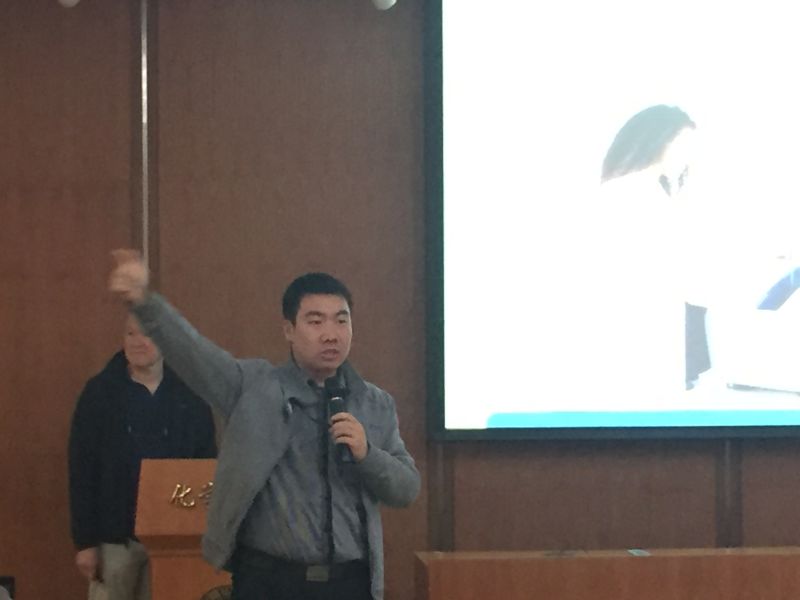 |
|
2016.10.14
|
We have recently installed the Bruker E580 X-band electron spin resonance spectrometer. This EPR spectrometer is equipped with both continous wave(cw) and pulsed function.
For the cw cavity, the highest quality factor for the empty cavity is about 20000, one can detect the at least 1.2*10-9 spins in this cavity. The lock-in detector mode(320 microsec/point to 5 sec/point), rapid scan(10 usec/point) and transient mode (8 ns resolution) is possible for cw measurement.
For the pulsed microwave bridge, the EPR is equipped with a solid state emplifer up to 300W. The pulse length resolutes at 2 ns and lasts at least 4 ns. The dead time of the pulse function is 74 ns for echo measurement (protection pulse covers half echo).
A Programmable one axis Goniometer is also available for both pulse and cw measurements.
Two distinct cryostats for pulse and cw cavities enable an low temperature environment of liquid helium temperature.
|
 |
|
2016.10.10
|
We have recently installed the Bruker E580 X-band electron spin resonance spectrometer. This EPR spectrometer is equipped with both continous wave(cw) and pulsed function.
For the cw cavity, the highest quality factor for the empty cavity is about 20000, one can detect the at least 1.2*10-9 spins in this cavity. The lock-in detector mode(320 microsec/point to 5 sec/point), rapid scan(10 usec/point) and transient mode (8 ns resolution) is possible for cw measurement.
For the pulsed microwave bridge, the EPR is equipped with a solid state emplifer up to 300W. The pulse length resolutes at 2 ns and lasts at least 4 ns. The dead time of the pulse function is 74 ns for echo measurement (protection pulse covers half echo). A Programmable one axis Goniometer is also available for both pulse and cw measurements.
Two distinct cryostats for pulse and cw cavities enable an low temperature environment of liquid helium temperature.
|
 |
|
2016.08.22
|
We have synthesized two dinuclear dysprosium complexes with the Dy(III) ions bridged by the neutral bipyrimidine (BPYM) ligand. They crystallized in a monoclinic and triclinic crystal system with almost the same structural core, only differing in the lattice solvent molecules. Alternating current susceptibility measurements revealed that they exhibit significant slow relaxation of magnetization until 25 K in the absence of a dc field. The single and double relaxation processes were assigned to one and two types of Dy(III) environments in the two dimmers, respectively, with barriers of 266 and 345 K under zero field conditions. The magnetic hysteresis loops of 1 and 2 were both observed up to 2.5 K. These results have now been published online in Dalton Trans.
|
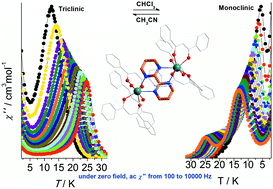 |
|
2016.07.06
|
Three doctoral, GAO Chen, CHEN Sa and BI Ye, graduated from our group. We wish them a bright future.
|
|
|
2016.07.03
|
XU Ling completed his postdoctoral work in our group, and now serves as a teacher in Hunan Normal University.
|
|
2016.06.02
|
Prof. GAO Song was elected vice president of China Association for Science and Technology(CAST) at the 9th National Congress of CAST.
|
|
2016.05.27
|
We have synthesized a series of single-molecule magnets, [ADyL4]·[solvent], where L is a naphthyridine-like ligand and A is an alkali metal ion. [ADyL4] is thermostable, and the geometric structure and magnetic properties remain unchanged after sublimation. Luminescence measurements at 5-77 K were performed to understand the relaxation pathway of magnetization. The luminescence spectra under a magnetic field (0-36 T) for the Dy-SMMs are investigated for the first time and analyzed with Zeeman formula. These results have now been published online in Chem. Sci.
|
|
|
2016.04.08
|
Prof. Dr. Manfred Scheer from University of Regensburg visited our group, and provided a Xingda Lecture entitled "The Magic of Polypnictogen Compounds".
|
|
|
2016.04.06
|
On the basis of a field-induced single-ion magnet [(dtc)3Dy(phen)] (dtc-=diethyldithiocarbamate anion), replacing two of the S-based dtc- ligands with O-based dbm- ligands (dbm- = dibenzoylmethanoate anion) leads to a significant enhancement of magnetic anisotropy, yielding a rarely reported sulfur-ligated lanthanide-based single-ion magnet [(dbm)2Dy(dtc)(phen)]. Ab initio calculations reveal that the gz value of [(dbm)2Dy(dtc)(phen)] is much larger than that of [(dtc)3Dy(phen)]. These results have now been published online in Dalton Trans.
|
|
|
2016.04.06
|
In the recent few months, the MMM group has some new members joining us. Miss ZHAO Yin-Hua, graduated from Capital Normal University, Miss XU Mei-Xing, graduated from Fudan University, and Mr. LIU Zheng graduated from China University of Mining and Technology have now officially joined our group as Ph.D candidate students. Meanwhile, we have now a new group secretary Miss CUI Hua-Li since the 1st of April. We warmly welcome the new members joining the MMM group.
|
|
2016.03.16
|
We have synthesized a niccolite series of [bnH22+][M(HCOO)3]2, these compounds shows four kinds of metal-dependent phase transition, from high temperature para-electric phases to low-temperature ferro-, antiferro-, glass-like, and para-electric phases. The comformational flexibility of bnH22+ and the different metal ions lead to different phase transitions and dielectric responses. The magnetic members display a coexistence or combination of electric and magnetic orderings in the low-temperature region. These results have now been published online in Chem. Eur. J.
|
|
|
2016.03.04
|
We have synthesized a series of new sandwich type lanthanide complexes with boratabenzene and cyclooctatetraenyl ligands, [(C5H5BR)Ln(COT)]. The structures were characterized by single crystal X-ray diffraction. The erbium complexes exhibited slow magnetic relaxation under zero field while the dysprosium complexes 4Dy−6Dy did not. 2Er featured the highest energy barrier (300 cm-1) among all reported erbium single-ion magnets. The influence of boron substituent on the magnetic properties was highlighted by ab initio calculations. These results have now been published online in Inorg. Chem. Front.
|
|
|
2016.02.26
|
Our group held the Joint Magnetic Molecular Materials Workshop 2016 (JMMM 2016) on Feb. 25-26 as a part of the joint NSFC-RS project at College of Chemistry and Molecular Engineering, Peking University. Dr. Alan Drew, Dr. Anthony Phillips, and Ms. Han Shuo from Queen Mary, University of London were invited to give lectures on muon spectroscopy and inelastic neutron scattering as powerful tools to investigate the magnetic structures and spin dynamics of templated metal formate frameworks and single ion magnets.
|
|
|
2016.02.02
|
We have discovered two thermal stable single-ion magnets containing Dy3+ with fluorinated β-diketone (fod) and bpy or phen ligands. They both exhibit temperature dependent process and quantum tunneling relaxation under zero dc field. Interestingly, one of them evaporates at 269 °C to form an amorphous compound, changing little in the local structure and keeping the SMM property, but the relaxation barrier shifts from 87 K to 122 K and the quantum tunneling becomes slower. These results have now been published online in CrystEngComm.
|
|
|
2016.01.29
|
We have discovered that two compounds of non-Kramers thulium ion, [(Tp)Tm(COT)] and [(Tp*)Tm(COT)], exhibit SMM behaviors in dc field and under dilution in zero field. Relativistic ab initio calculations combined with single-crystal angular-resolved magnetometry revealed the easy axis anisotropy and nearly degenerated ground doublet. The importance of local symmetry for obtaining Tm SMMs is highlighted. These results have now been published online in Chem. Eur. J.
|
|
|
2015.12.29
|
We have discovered a rare phase transition in [CH3CH2NH3][Cu(HCOO)3]. The compound undergoes an irreversible thermal phase transition from a perovskite to a diamond structure at 357 K, accompanied by a bridging-chelating switch of the coordination mode of a formate ligand. The reverse process can be induced by pressure at room temperature but not cooling under ambient or lower pressure. These results have now been published online in Angew. Chem. Int. Ed.
|
|
|
2015.11.13
|
Prof. Peter J. Hore from Oxford University visited our group, and provided a Xingda Lecture entitled "Do birds use chemical reactions to navigate?"
|
|
|
2015.11.13
|
The new group website is released.
|
| |
|
| |
|
| |
|
| |
|
| |
|
| |
|
| |
|
| |
|
| |
|
| |
|
| |
|
| |
|
| |
|
| |
|
